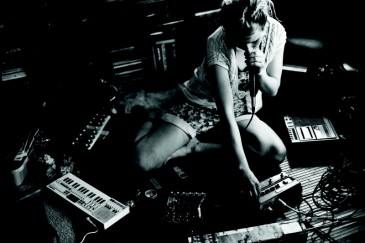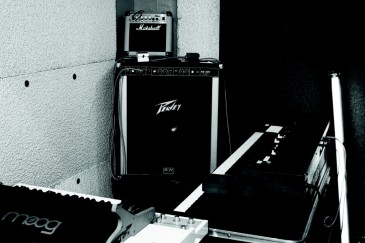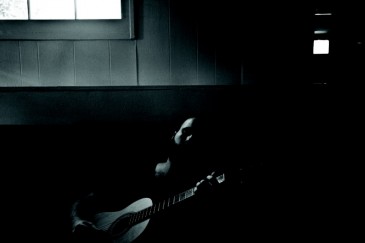
The relationship between musicians and their gear is a curious one. Some relationships are cinematic love stories while others develop a little more awkwardly. However awkward or romantic the connection is, the fact is, it’s a necessary and fundamental arrangement for the creation of music. I spent some time with a few of Vancouver’s forthcoming artists and explored their unique love, distaste and passion for all things instrumental.
PrOphecy Sun
I arrived at PrOphecy’s home a little after 2 p.m. on a warm Sunday afternoon curious to see what this experimental artist used to create her rhythmically haunting ambiance. After meeting Velcro and Gorby, PrOphecy Sun’s twin cats, we sat down on her living room floor amongst an array of gadgets, tape recorders and other unlikely instruments. I wasn’t surprised to discover that her parents were both musicians, her mother was a vocalist and played guitar and her father was a percussionist who loved simple and unique sound.
“My dad has this really weird relationship with sound which I think has really affected me. He would do things like play sounds of bells or birds and say to me ‘Listen to this!’ and I would be like, ‘Dad, this is really weird,’” she explained. Clearly this exposure to “weird” sounds has permeated PrOphecy Sun’s current style and selection of instruments—which includes two Eiki cassette tape recorders, a digital hand recorder, a Casio PT-30, a Little Tikes kids piano, a beat up harmonica, a theremim, a morse code taper and an effects pedal (with a looping feature) amongst other things.
“[The] instruments I used were probably shakers, little shaky things—’cause my parents would be playing, and I would be banging things—whether it’s pots or pans or making acoustic sounds to whatever they were doing. It’s weird. But I’d say my first ‘instrument’ was my voice. I’ve had more of a relationship with the sounds that come out of me and kind of how it relates with my body and physicality.”
Her voice is indeed a powerful instrument. When used with the effects pedal, it takes on her signature ghostly presence, bundled with fourth, fifth and sixth generation field recordings made with her digital and cassette tape recorders and various clicks and taps from a tapper and shaker, it becomes a heavily layered work. Throw in the eerie sounds of a homemade theremin and you have a pretty unique sound. PrOphecy Sun’s gear is mostly made up of fairly inexpensive “garage sale items” but she mentioned that her effects pedal is her centerpiece. “I’d say the effects pedal is how I can create my atmosphere. It’s the key to allow me to layer. I can layer a certain amount with my tape players, but it’s… it’s… kinda like my mother ship and these [other instruments] are my subsidiaries, little floating ships.”
Ryan McCormick (Collapsing Opposites)
Collapsing Opposites started as a solo recording project in Ryan McCormick’s bedroom sometime around 2002. Using an RC20 LoopStation and a MXR micro amp McCormick pieced and looped songs into existence. More members gradually joined and now McCormick tends to shy away from using the original pedals.
“Dudes would come up to me after a show and be like ‘Whoa dude what are those crazy pedals? You got the DD6 and the RC20 and the Micro amp!’ And I’d be all ‘I just got whatever they gave me at the store I don’t even remember.’ It seemed to attract gear guys. It actually started to bug me after a while. People would kinda be more interested in the gear than the songs in some ways … Eventually that made me turn the other way and use less and less gear,” McCormick explained. “It would be nice to completely not use it, cause it’s kind of a hassle to set it all up and everything. I love just seeing a band that’s super simple and they just plug in their stuff and go, you know that don’t need all these cords and wires.”
McCormick tends to use his old 1965 Yamaha electric guitar along with his bandmates Jarrett Evan Samson on bass, Jessica Wilkin on keyboard and Laura Hatfield on drums for a fuller, quirkier sound—a rather drastic change since their first album that almost exclusively used the pedals.
In the past year the band has also been hosting an art exhibition on Hatfield’s Canwood maple kick drum. Various artistst have been doing work on the beautiful Alberta-made drum. The artist Emiliano Sepulveda has recently added a spectacular photo-lenticular structure entitled Object for Passive Light Show. More can be seen at fouronthefloorprojects.blogspot.com.

Bruce Ledingham (Red Cedar)
“Key Crazy” is the term Bruce Ledingham used to describe himself during our meeting at Red Cedar’s Vancouver character home. Ledingham grew up with piano in the house but never really took to it, preferring to play guitar. Then three years ago a lightning bolt struck.
“I saw the keys player from the Decemberists [Jenny Conlee] playing a real Hammond tone wheel organ and the expression you could achieve with it, the amount of emotion that come out of one of those things was amazing,” Ledingham explained. And it seems he’s never looked back.
Ledingham owns an impressive collection of rare keyboards and organs which consist everything from modern portable alternatives to classic organs used in the ’70s, ranging from a Hammond B3 Digital Organ, Moog analogue synthesizer, to his prized Rhodes digital piano.
“The Rhodes piano … I have a very rare version. It was only in production for half a year in ’84 and it was the last model they ever made—arguably the ultimate form of the Rhodes piano. There are only 1,100 in the world. I managed to track one down and drove all the way to Edmonton to get it. So for me it has massive sentimental value. I’ll never sell it—never get rid of it!”
Ledingham also has a Memotron synthisizer with a digital duplicate of a Mellotron electro-mechanical polyphonic keyboard. “They’re this funky keyboard from the ’60s, ’70s—that used tape loops. Each key had an assigned magnetic tape loop for eight seconds of any sampled instrument of anything in that key, so you’ll have flutes, strings, choirs, guitars… anything. And it had a lot of quirky character and hiss. … It’s kinda the classic ensemble of ’70s keys, but modernized.” [ ed. Like the one from Ferris Bueller’s Day Off!]
Deeply inspired by Pink Floyd’s Richard Wright’s richly textured work, Ledingham relentlessly pushes forward, always adding to his gear and style.

Jarred Greff (The Greff Band)
Jarred Greff is shopping for a new acoustic guitar. His last, which also happened to be his first, which was bought 15 years ago, was recently crushed. Down in the basement of the Greff brothers Jarred and Scott’s rehearsal space Jarred told me the story. “My brother’s girlfriend kinda accidentally sat on it. [laughs] Actually, I handled it really well because I realized it was more my fault. I put it under the couch leg ’cause I was glueing the bridge and didn’t have a wood clamp and the only thing that I found that was the right weight that wouldn’t be too heavy and push through, was the leg of the couch!”
After giving me the rundown on his current gear—including a Fender Telecaster Highway One Series guitar, a 2×10 combo Laney amplifier and two reverb pedals, I realized that, much like his musical stylings, Greff enjoyed a “stripped down” approach to his gear.
“We have a mandolin, I think it’s from about 1918 or 1920. My grandmother ended up passing away three years ago and she left us a really small inheritance and so me and my brother figured we should go in together and buy something that we could kinda keep but still could use. And so we bought this super old mandolin that was roughly around the age that she was. … I love the sound. It’s got character,” Greff told me. “Character” seems to be an important element when selecting a new piece of gear for Greff. “Whatever instrument you play on will dictate how you work in the future and the style you come out with, so I’ve kinda been choosy to what I put into my guitars.”
With his equipment bearing various dings, scratches and worn edges, there’s no babying going on here.
“Theres definitely a personal connection for most musicians and their gear—like I can’t count the amount of times I’ve actually slept with my guitar. It feels good. It feels right. [laughs] Wait! That makes me sound lonely.”
More of Shaun Stander’s work can be found at www.shaunstander.com

